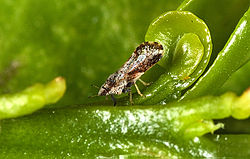- Diaphorina citri
-
Diaphorina citri 
Asian citrus psyllid, Diaphorina citri Scientific classification Kingdom: Animalia Phylum: Arthropoda Class: Insecta Order: Hemiptera Suborder: Sternorrhyncha Superfamily: Psylloidea Family: Psyllidae Genus: Diaphorina Species: D. citri Binomial name Diaphorina citri
Kuwayama, 1908The Asian citrus psyllid, Diaphorina citri, is a sap-sucking, hemipteran bug in the family, Psyllidae. It is an important pest of citrus being one of only two known vectors of the serious citrus disease, Huanglongbing or greening disease. It is widely distributed in southern Asia and has spread to other citrus growing regions. The other vector is the African citrus psyllid, Trioza erytreae.
Contents
Distribution
The Asian citrus psyllid originated in Asia but it is now also found in parts of the Middle East, South and Central America, Mexico and the Caribbean. In the United States, this psyllid was first detected in Florida in 1998 and is now also found in Louisiana, Georgia and South Carolina.[1] In Southern California, where it first appeared in backyard citrus in 2008, an eradication programme has been instituted to try to prevent it becoming established.[2] In the whole of the United States and its territories, areas where this psyllid are found are under quarantine restrictions.[3]
Description
The adult psyllid is about four millimetres long with a fawn and brown mottled body and a light brown head. It is covered with a whitish, waxy secretion which makes it look dusty. The forewings are broadest at the back and have a dark edging around the periphery with a pale gap near the apex. The antennae are pale brown with black tips. These features distinguish it from the superficially similar African citrus psyllid. It typically adopts a head down, tail up posture as it sucks sap. Aphids are often also present on citrus and psyllids can be distinguished from them by being more active, jumping insects, whereas aphids are sedentery. In addition, the antennae of a psyllid has ten segments whereas those of aphids usually have four or six segments. Most aphids have cornicles on the abdomen and psyllids lack these.[1]
The psyllid nymph moults five times. It is a yellowish-orange colour and has no abdominal spots. The wing pads are prominent, especially in the later instars.[1]
The eggs are approximately 0.3 millimetres long, almond-shaped, thicker at the base and tapering toward the top. They are at first a pale colour but turn yellow and later orange before they hatch. The long axis is placed vertical to the surface of the leaf.[1]
Life cycle
Eggs are laid on the tips of growing shoots, between and near the unfolding leaves. A female may lay up to 800 eggs during her lifetime which may be several months. The whole development cycle takes from two to seven weeks depending on the temperature and the time of year.[4]
Damage
Psyllids nymphs are found on new shoots of citrus trees. As they feed they produce a toxin that causes the plant tips to die back or become contorted and prevents the leaves expanding normally. Of more importance is the fact that they are vectors for the bacteria that causes one of the most devastating of citrus diseases, huanglongbing. Affected trees bear small, asymmetrical fruit which are partially green and which are unsaleable because of their poor size and quality.[2]
Control
The Asian citrus psyllid has a number of natural enemies including hoverflies, lacewings, several species of ladybird and a number of species of parasitic wasp.[5] One of these wasps, Tamarixia radiata, has proved very effective at controlling the pest and has been successfully released and become established in a number of citrus growing areas including Florida.[6] Both adults and nymphs of the psyllid can be controlled by the use of a wide range of insecticides.[7] Citrus greening disease is best controlled through an integrated strategy involving the use of healthy planting material, the prompt removal of infected trees and branches and the control of vectors.[8]
References
- ^ a b c d Featured Creatures
- ^ a b Center for Invasive Species Research
- ^ UDSA
- ^ Husain MA, Nath D. 1927. The citrus psylla (Diaphorina citri, Kuw.) (Psyllidae: Homoptera) Memoirs of the Department of Agriculture India 10: 1-27.
- ^ Waterston J. 1922. On the chalcidoid parasites of psyllids (Hemiptera, Homoptera). Bulletin of Entomological Research 13: 41-58.
- ^ Hoy MA, Nguyen R. 2001. Classical biological control of Asian citrus psylla. Citrus Industry 81: 48-50.
- ^ Bindra OS, Sohi BS, Batra RC. 1974. Note on the comparative efficacy of some contact and systemic insecticides for the control of citrus psylla in Punjab. Indian Journal of Agricultural Science 43: 1087-1088.
- ^ http://www.springerlink.com/content/n74v37l632t71k0v/
External links
- Species Profile-Asian Citrus Psyllid (Diaphorina citri), National Invasive Species Information Center, United States National Agricultural Library. Lists general information and resources for Asian Citrus Psyllid.
Categories:- Psylloidea
- Agricultural pest insects
- Invasive animal species in the United States
- Animals described in 1908
Wikimedia Foundation. 2010.

